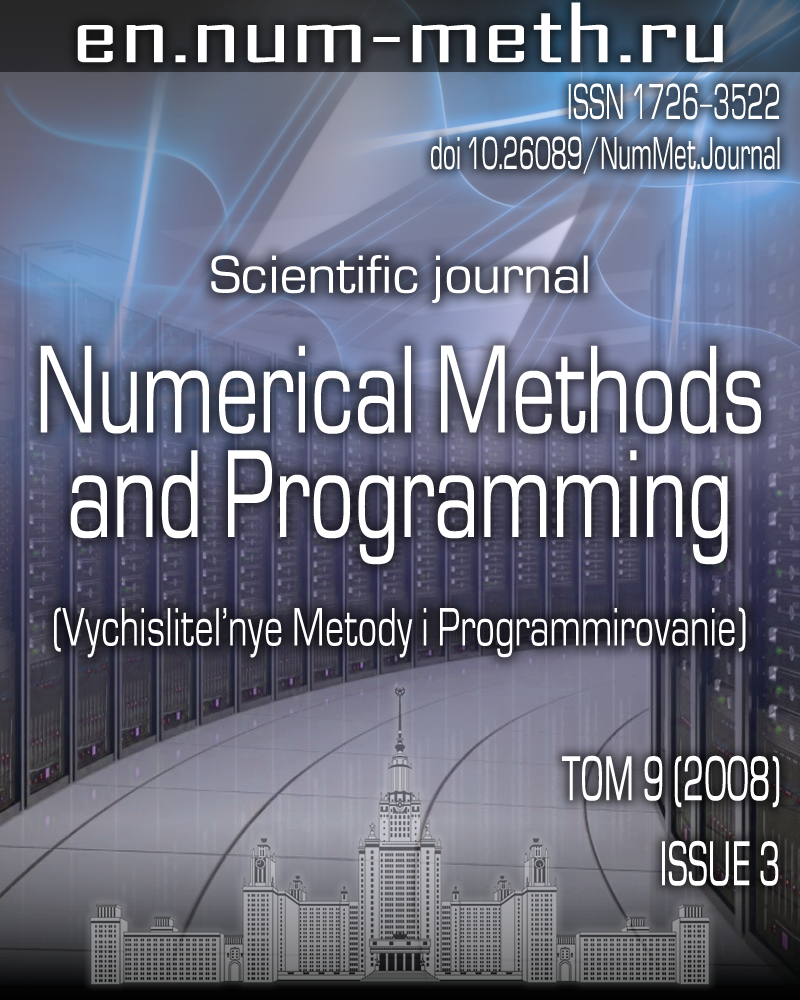Mathematical simulation of creep processes in metal patterns made of materials with different extension compression properties
Keywords:
Abstract
An algorithm for numerical solving the problems of creep in metal patterns made of materials with different extension and compression properties has been developed. The spatial discretization of nonlinear equations of solid mechanics is performed by the finite element method. To solve the three-dimensional problems, the 8-node isoparametric finite elements with trilinear approximation of geometrical parameters and displacements with respect to their values at the nodal element points have been used. The spatial discretization of equations is accompanied with the step-by-step procedure of time integration of quasi-static deformation equations with an iterative solution refinement at each discrete instant of time. The algorithm of determining the stress tensor components for defining creep constitutive relations has been presented with allowance for different properties of materials when extending and compressing. This algorithm has been implemented in a new material model of PIONER code and in the crplaw.f subroutine applied for the implementation of new creep models into MSC.Marc 2005 code. The problems of twisting during the creep of metal plates under constant concentrated forces applied at the corner points have been solved. Comparisons of the obtained numerical solutions with data of the full-scale experiments have been worked out. It is shown that the new model of material allows one to achieve a better correspondence of calculations and experimental data as compared to using the standard models of material (having the same properties when extending and compressing) being at hand in material libraries of PIONER and MSC.Marc 2005 codes. Keywords: mathematical simulation, creep, finite element method
Published
Issue
Section
References
- Работнов Ю.Н. Ползучесть элементов конструкций. М.: Наука, 1966.
- Работнов Ю.Н. Механика деформируемого твердого тела. М.: Наука, 1988.
- Соснин О.В., Горев Б.В., Никитенко А.Ф. Энергетический вариант теории ползучести. Новосибирск: Институт гидродинамики им. М.А. Лаврентьева СО АН СССР, 1986.
- Никитенко А.Ф. Ползучесть и длительная прочность металлических материалов. Новосибирск: Институт гидродинамики им. М.А. Лаврентьева СО РАН, 1997.
- Bathe K.-J. Finite element procedures. Upper Saddle River: Prentice Hall, 1996.
- Zeinkiewicz O.C., Taylor R.L. The finite element method. Oxford: Butterworth -Heinemann, 2000.
- Curnier A. Computational methods in solid mechanics. Dordrecht: Klüwer Academic Publ., 1994.
- Коробейников С.Н. Нелинейное деформирование твердых тел. Новосибирск: Изд-во СО РАН, 2000.
- MARC Users Guide. Vol. A: Theory and Users Information. MSC. Software Corporation, 2005.
- Соснин О.В., Горев Б.В., Рубанов В.В. Кручение квадратной пластинки из материала, разносопротивляющегося растяжению и сжатию при ползучести // Расчеты прочности судовых конструкций и механизмов. Сборник трудов НИИВТа № 117. Новосибирск: НИИВТ, 1976. 78-88.
- Цвелодуб И.Ю. Постулат устойчивости и его приложения в теории ползучести металлических материалов. Новосибирск: Изд-во ИГиЛ СО РАН, 1991.
- Голованов А.И., Бережной Д.В. Метод конечных элементов в механике деформируемых твердых тел. Казань: ДАС, 2001.
- MARC Users Guide. Vol. B: Element Library. MSC. Software Corporation, 2005.
- Korobeinikov S.N., Agapov V.P., Bondarenko M.I., Soldatkin A.N. The general purpose nonlinear finite element structural analysis program PIONER // Proc. Int. Conf. on Numerical Methods and Applications.
- Новожилов В.В. О принципах обработки результатов статических испытаний изотропных материалов // Прикл. матем. и механ. 1951. 15, № 6. 709-722.
- MARC Users Guide. Vol. D: Users Subroutines. MSC. Software Corporation, 2005.
- PATRAN Users Guide. MSC. Software Corporation, 2005.
- Kojic M., Bathe K.-J. The effective-stress-function algorithm for thermo-elasto-plasticity and creep // Int. J. Numer. Meth. Eng. 1987. 24. 1509-1532.
- Timoshenko S., Woinowski-Krieger S. Theory of plates and shells. N.Y.: McGraw-Hill, 1959; Тимошенко С.П., Войновский-Кригер С. Пластинки и оболочки. М: Физматгиз, 1963.
- Matthies H., Strang G. The solution of nonlinear finite element equations // Int. J. Numer. Meth. Eng. 1979. 14. 1613-1626.
- MARC Users Guide. Vol. C: Program Input. MSC. Software Corporation, 2005.
- Strang G., Fix G.J. An analysis of the finite element method. Englewood Cliffs: Prentice Hall, 1973; Стренг Г., Фикс Дж. Теория метода конечных элементов. М.: Мир, 1977.
- Hughes T.J. R. The finite element method: linear static and dynamic finite element analysis. Englewood Cliffs: Prentice-Hall, 1987.


